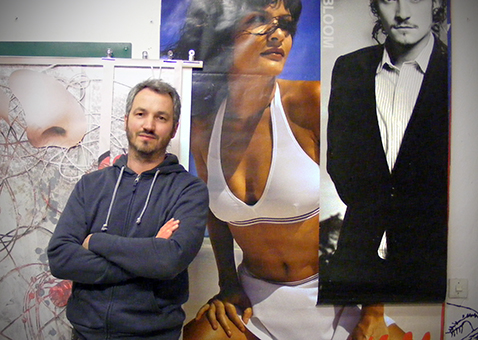wanderlust
Naked Women Don’t Make Me Angry…

Making my way to artist Peter Freitag’s studio I am struck at how beautiful Prenzlauerberg really is. Quaint shops and cafes, a church, kids playing everywhere and riding their bikes, it really is sweet. Making my way into Freitag’s studio, however, reality kicks in when I am greeted by the massive image of a bronzed, bikini clad woman kneeling suggestively for an H&M ad which is attached to one wall. Grimacing I sit down, and begin the interview in Freitag’s otherwise very nice work space.
BAPS: Hi Peter, tell us a little about your creative roots.
PF: Oh my god…is building towers with little bricks part of the creative process?! I think the first sculpture that I made was with my brother, a snowman – a really good one though, not just three balls, one with real arms and legs! I don’t know how creative that was, but it was fun – you play a lot in the countryside.
My biology teacher who did a photo course at my school was maybe the one who pushed me creatively. I always thought you make a photo, and then you enlarge it and then it’s good; but he gave me a whole film and said “Ok, you have one hour to make this film full.” This was the first time I realised that you have to work a lot to do one piece, so for me it was the moment where I got the feeling you need material to do something, and be creative and not just wait for that one moment that happens.
In the end we made contact prints and he said only one was good – I said what about the other 35? And he said “No this one is the best, we make this one.” That was really a moment where I realised you have to make good choices.
BAPS: Indeed, as Henri Cartier-Bresson said, “Your first 10,000 photographs are your worst.” So what happened next, did you pursue art as a career?
PF: After I finished school I thought I would like to go to art school, but I came from a farming background. My mother was a bit creative and I helped her with sewing, but I didn’t have a real art background so it was hard for me to get started at home.
I was born in the north of Bavaria in a village with only 250 people, predominantly Catholic. I met my biology teacher again and we had a coffee, and I explained that I was thinking about going to do art. He said ask your father for money. If he says yes then you go to art school, if he says no you go to work, earn the money and then go to the art school but I don’t want to hear you talking about it like this! I decided he was right.
BAPS: He sounds like a great guy. Most of your work is based on advertising – do you think coming from that very small rural background had an impact on how you experienced seeing advertisements for the first time?
PF: I was in a sports team and we had a lot of training weeks in Berlin when I was around 13, and I stayed at the Olympia stadium and did a tour through Kudamm. Yes I was impressed by the lights and the city and ads and stuff, and of course it makes an impression. I think I realised fast though that this world just shows you an ideal you can’t reach.
Parallel Worlds
I think also coming from a catholic background where everyone tries to be so holy is also a similar structure – trying to make a perfect world you can’t realise. There’s always this distance of how you are and how they want you to be.
I went through these phases of being an abstract painter at school, trying to paint and make it look nice, and then after a while I started to paint advertisement photos. It was a very early thing after I decided I didn’t want to paint abstract anymore, so I started to paint in kind of collage type of way (at this stage Freitag points fondly to an early painting on the wall which is clearly from an earlier stage in his career, but not aesthetically displeasing).
I think my current work with all these lines where parts of the image are erased with sandpaper for me is more reminiscent of where I come from. I always enjoyed painting but I don’t want to do it anymore, that’s not how I see the world, I do not create something from zero – for me it’s a collage world, I need to do collages with images and things that I find. It’s a way of referencing painting without doing painting in a contemporary way.
Be the first to write a comment.
Your feedback
